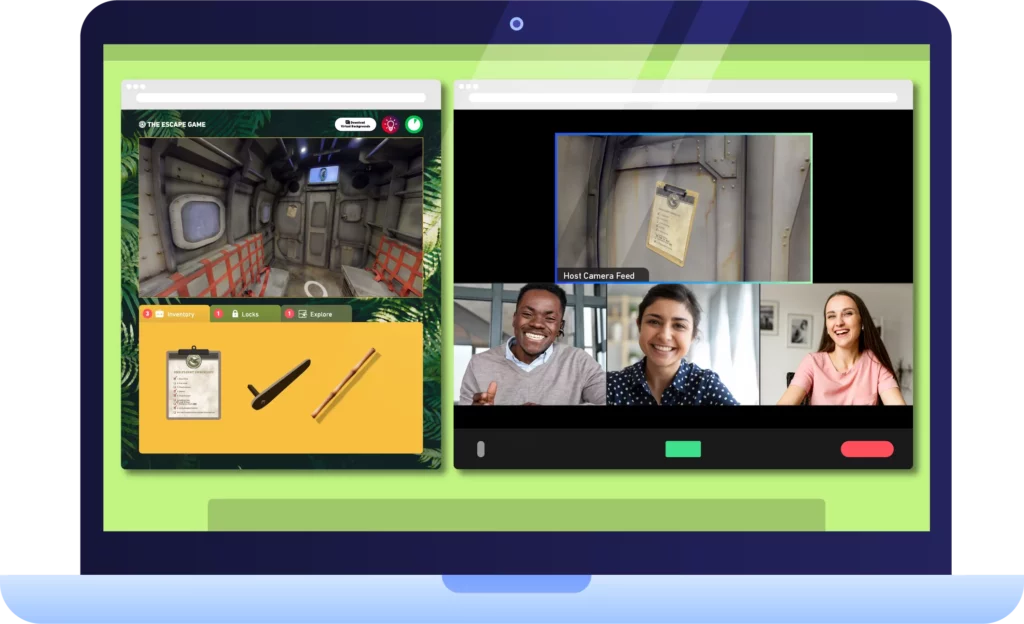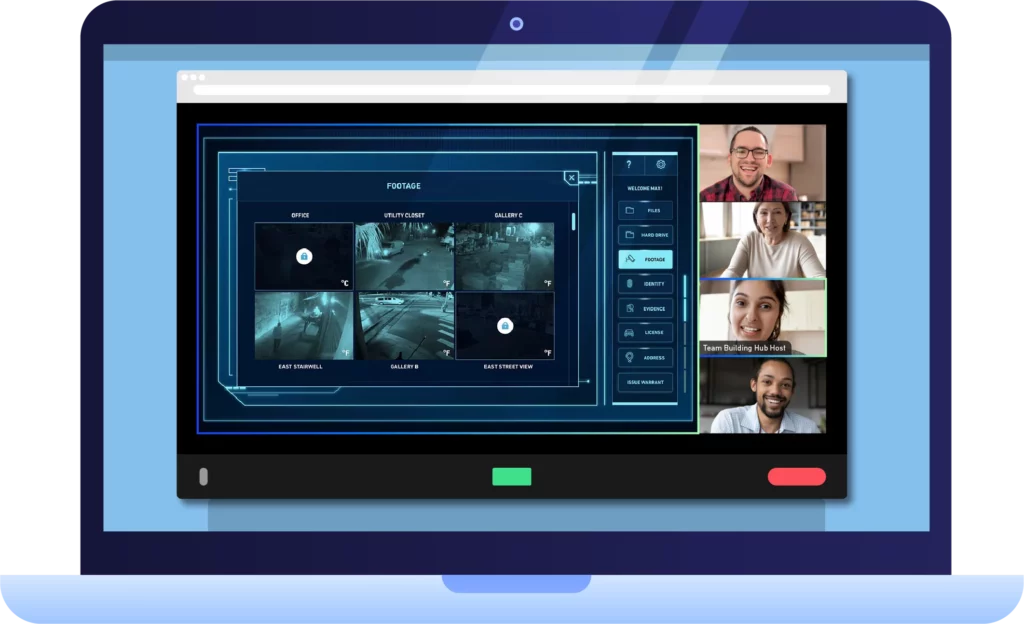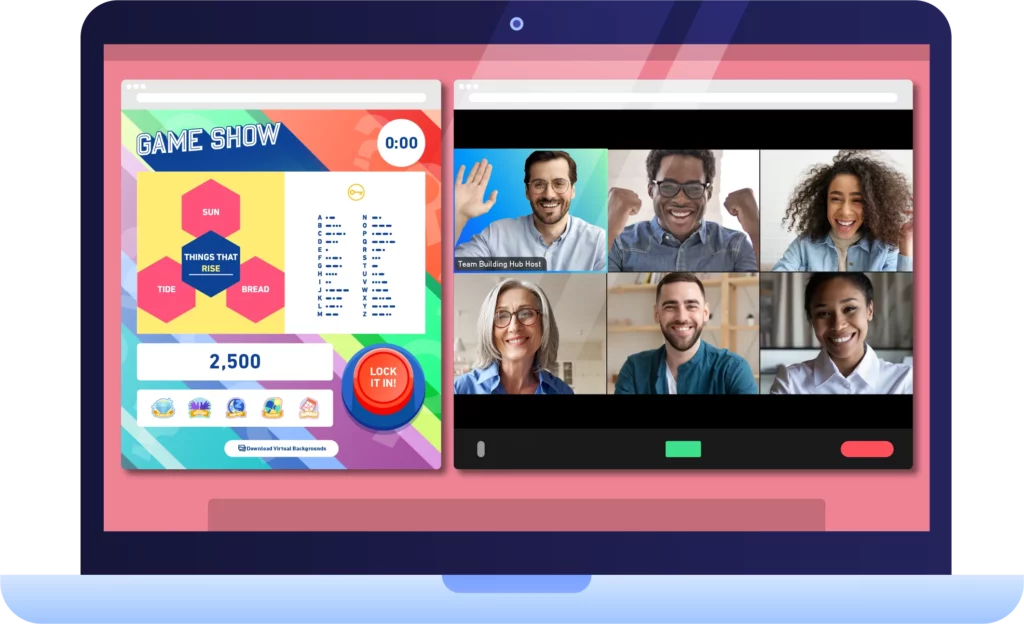As more and more companies embrace the remote work model the demand for effective remote team leaders will increase. According to one study, 73% of all teams will have remote workers by 2028.
Remote teams pose unique challenges to companies and the lack of leaders versed in virtual team management can have a major impact on productivity and morale.
If your company is fully or partially remote, it’s imperative that you provide your team leaders with opportunities to develop the required skills to keep your remote teams productive and successful.
In addition to any formal training you offer your remote employees, there are some effective and fun virtual leadership development activities that you and your team can engage in. Playing these virtual games will bring out the best remote leadership qualities in your employees so that everyone on the team can step up to the plate if needed!
Table of Contents
Why Is Developing Remote Leadership Skills Important?
How Do You Develop Virtual Leadership Skills Effectively?
What Virtual Leadership Activities Are The Best?
Why Is Developing Remote Leadership Skills Important?
One study reported in Forbes, analyzed 60 team leadership skills, looking for any differences between in-person and remote team leaders. While a large majority of skills and behaviors were the same, the study revealed increased importance of several behaviors. Remote leaders communicate clearly, problem-solve creatively, and display empathy. They also listen actively and build relationships.
Without a great team leader, remote teams can quickly become dysfunctional. Communication breaks down, problems go unsolved, feelings get hurt, and morale plummets. When a team is this dysfunctional, productivity inevitably hits an all-time low. Retention rates drop and your bottom line suffers. You can’t afford to neglect to implement virtual leadership training activities for your employees!

How Do You Develop Virtual Leadership Skills Effectively?
There is no such thing as a “born leader”. Some individuals possess certain innate characteristics that lend themselves to leadership but everyone has some basic leadership aptitude. Here are the top skills every great remote leader should have and continue to develop:
Communication
Remote team leaders need to be able to communicate concepts, instructions, and systems succinctly and clearly. Great remote leaders pick up on non-verbal communication just as much as verbal communication. They must feel comfortable speaking in all settings such as one-on-one conversations, team meetings, and company-wide events.
Problem-Solving
In a remote workplace, good leaders must be able to problem-solve efficiently and creatively. An array of previously uncommon obstacles can crop up in a company operating remotely. From technology snafus to disruptions among the team due to miscommunication, a solid remote leader must have the ability to correct these problems swiftly and set everything right so coworkers can carry on as normal.
Active Listening
Active listening is more than just hearing another’s words. Active listening includes hearing words being spoken and the intention and emotion behind them. Active listeners also know how to respond appropriately. Remote team leaders who actively listen to their team members make them feel understood and appreciated. This bolsters employee motivation and morale.
Empathy
Lack of empathy among company management is why many employees quit their jobs. When it comes to being a good remote leader, having empathy for others is a must. Empathy allows team members to understand each other’s perspectives and needs and this leads to better collaboration. Just as important is the effect that empathy can have on company culture, especially at a time when remote workers may feel isolated or down. When team leaders have the ability to empathize, they inspire others to be more caring too.
Relationship Building
A team of disparate people needs someone to guide them to build relationships together. Virtual activities where team members have to share a bit of themselves with the group are a first step toward the creation of team cohesion. Great virtual team leaders recognize the importance of fostering bonds among team members and create intentional moments to encourage individuals to connect with each other.
Self-Reflection
Self-reflection is essential to effective leadership. After all, you can’t know if you’re doing a good job without some assessment. In order to improve leadership abilities, one must continually reflect upon strengths and weaknesses. Self-awareness of behaviors towards others helps leaders know if their leadership style is working or not, how others are perceiving their authority, and if team members feel supported by a caring superior.
Boost Morale
Every team needs a cheerleader! A good remote team leader keeps spirits high through engaging virtual team building activities! They also hold regularly scheduled one-on-ones. Connecting with remote team members is vital to their happiness and success since they can’t just pop into your office with questions or concerns. One-on-ones are also ideal for leaders to let remote workers know they are appreciated. Employees who feel valued are happier and this translates into higher company morale.

What Virtual Leadership Activities Are The Best?
Here are 19 of the best virtual activities for leadership development. These games teach individual team members to communicate more effectively and listen more actively, use creative thinking when problem-solving, self-reflect, feel empathy, and nurture relationships. These games help team members recognize great leadership traits and if they have what it takes.
1. Personality Tests
Personality tests let team members learn about each other’s traits, talents, and weak spots. Finding similarities fosters bonds between group members. Understanding each other’s differences develops empathy.
The 5-Minute Personality Test is a fun and quick activity that lets players discover what leadership skills they have. This simple test categorizes people as one of these animals: Lions, Otters, Golden Retrievers, and Beavers. The game provides a long list of qualities that each animal possesses. While Lions are typically regarded as leaders, other animals have leadership traits as well. After taking the test, spend a few minutes talking about the results. Let each person say what attributes their animal has that would help them be a great leader!

2. Virtual Escape Rooms
During these immersive hour-long games, teams must work together quickly to solve puzzles and decipher clues to win before it’s too late! Being successful requires problem solving and communication. When playing a challenging collaborative game, leaders often emerge to keep the group moving in the right direction. Virtual escape rooms are one of the very best virtual leadership training activities.
3. Highs and Lows
When we are caught up in our own woes, it’s easy to forget that other people have their own problems to manage. This activity works well at the beginning or end of a team meeting. Give each team member two minutes to recount a high or low of their week. Actively listening to another person’s negative experiences allows members to develop empathy for others. If team members want to celebrate a high of the week, then the whole team can join in! By sharing a tidbit of their life, team members move one step closer to trusting relationships.
4. Virtual Happy Hour
Hosting a virtual happy hour is an engaging choice that can incorporate numerous virtual leadership activities that connect remote team members in a social setting. Giving different team members the opportunity to host a happy hour can help them develop their confidence, connections, and communication skills. Rotate hosts so that everyone has a chance to grow. If you want to skip the alcohol, try one of these other virtual events and party ideas!

5. Online Mystery Games
At the start of an online mystery game, your group splits into teams of “secret agents” sent on a top-secret mission! Teams then scour the internet for clues and interpret evidence like video surveillance footage. To solve the mystery, team members must delegate tasks and use their problem-solving abilities like never before. Virtual leadership training has never been so intriguing!
6. Desert Island Survival
Tell the group that they are each going to be stranded alone on a desert island. Ask them to choose just one thing they would bring with them. Go around the group and have everyone say what object they would bring and why they chose it. You can adapt this game to other scenarios, like a shipwreck or a plane crash in the mountains.
Take this activity one step further by asking the team to consider what roles they would play in a survival scenario. This encourages them to think about their individual talents and skills they bring to the group. For example, would they take charge of gathering food and finding shelter? Perhaps they would take on the task of getting off the island or keeping the group optimistic. Whatever role they choose, team members will see that they have applicable leadership skills to keep the group alive until they are rescued!
7. TED Talks on Leadership
Watching TED Talks about leadership is an excellent virtual leadership development activity. Talks vary on which leadership aspects they cover, but all offer insight into how to be a great leader. Here are a few of the best TED Talks on Leadership your team can watch together.
- How Great Leaders Inspire Action
- Storytelling: How to tell a leader from a manager
- 10 Ways to Have a Better Conversation
Follow up the viewing session with activities that allow team members to practice the leadership skills touched on in the videos. Try Role-Playing, the next game on this list! You can find more team building TED Talks here.

8. Online Game Shows
Online game shows are live, hosted competitions in which teams compete to win points and earn badges to make it to the top of the leaderboard. It’s easy to play these exhilarating games via Zoom. Once your team logs in to the Zoom call, a Host will greet you. After a few quick ice breakers, you’ll split up into teams, head into breakout rooms, and compete against each other for the highest score! You will be tasked with finding answers to puzzles and riddles, calling on your team’s problem-solving skills and ability to communicate well. Often during group games, one or two team members step up as leaders who help the group work through puzzles and come to a strong finish as a team!
9. Online Trivia
Virtual employees can sometimes feel disconnected and isolated. A great remote team leader recognizes when team morale is low and works to improve it. Studies show that when we play trivia games, our bodies release extra dopamine, also known as the “happy hormone”. Getting the team together to play online trivia will get them re-engaged as a team and literally feeling good!
10. Ice Breakers
Virtual meetings and social events can sometimes be awkward at first, or even a little tense. Strong team leaders recognize this and use ice breaker questions to put everyone at ease. Whether group members are meeting for the first time or already know each other, ice breakers build relationships. By answering questions like “What would your personal theme song be?” or “Would you visit Mars even if the round trip took a year?” team members can reveal a little bit about themselves and learn more about each other!
11. Role-Playing
This virtual activity played over Zoom lets team members see different leadership styles in action and how they impact employees. Ask for four volunteers who are comfortable role-playing. Have one volunteer play an employee who made a mistake on the job, like missing an important meeting. The other three volunteers will play team leaders who react to the employee’s error. Each volunteer responds with a leadership style different from the others.
After each performance, ask the whole group to reflect on the different leadership approaches. For example, the group could consider what worked well and what could be improved on to best benefit the team.
12. Aliens Have Landed
Aliens Have Landed is a quirky game to get your team members thinking way outside-the-box. The scenario is that aliens have recently landed on earth and are curious about your company and its culture. There’s just one problem: they don’t speak English! Split your group into teams and tell them that they can pick up to five objects to describe the company to the aliens. Teams use breakout rooms to discuss the task and choose their five objects. After 10 minutes, bring the groups together. Have a spokesperson from each group explain why their group chose the objects they did. This virtual game builds non-verbal communication skills and fosters collaboration.

13. Debatable
In this game, pick two people who will debate each other. Give the debaters a lighthearted debate topic, like “Which tastes better, Pepsi or Coke?” or “Should the toilet paper go over or under?” Though the topic is silly, debaters should try to be as persuasive as possible since the rest of the team will pick the winner!
This is a fantastic leadership virtual activity as it challenges players to communicate articulately while listening actively. How can you counter an opponent’s arguments if you aren’t truly listening to them? You can switch up which team members debate per round to give everyone a chance to practice their listening and communication skills.
14. Virtual Onboarding Buddy
Every new hire goes through the virtual onboarding process. Virtual onboarding is how new remote employees are integrated into the company. A key feature of virtual onboarding is making the new employee feel welcome. New employees are often assigned a virtual buddy, someone who serves as a casual source of information and a go-to for answers that aren’t in the company handbook.
Virtual buddies should be active listeners as new remote hires will likely have many questions during their first few weeks on the job. Virtual buddies also make introductions, which can lead to new office friendships which are hard enough for existing remote employees to make! Stepping up and volunteering to be a team buddy shows real leadership!
15. Ducks in a Row
This activity, played over Zoom, assists team members to create a step-by-step problem-solving process to refer to when an issue arises. Have participants form pairs and meet in breakout rooms. Tell them to come up with a list of no more than five steps that an effective leader would go through when faced with a difficult situation. Let the pairs have 30 minutes to discuss and choose what steps a good leader would take.
Bring the group back together and ask each pair to read out their steps. Then have the group discuss all the steps presented and decide by consensus the five most effective steps to take to solve a problem or handle a difficult situation. This activity leaves team members with a tool they can use when they are faced with an actual challenge at work.

16. Elevator Pitch
In this activity, team members must convey information succinctly and persuasively. An ‘elevator pitch’ is a term for a short descriptive overview of an idea or concept delivered in 30 seconds. Prior to the activity, ask your team members to create an elevator pitch about themselves and what makes them special. Then bring your team together in a Zoom meeting where they will each make their ‘elevator pitch’. Not only does this activity develop quick-thinking, remote leadership communication, but it also empowers team members to acknowledge their strengths and provisions to the team.
17. Tell a Story in 60 Seconds
This quick game packs a punch! Pick a common topic about experiences that most of your team members can likely relate to. Ask each team member to recount a personal story about that topic. The challenge is that they get just 60 seconds to tell their story! This game requires efficient communication skills, one skill that a great remote leader needs.
18. Who and Why
Great leaders inspire others with both their words and their deeds. This simple but excellent virtual leadership activity asks team members to think about who are or have been the most influential leaders in their lives. Ask them to choose just one and then go around and have everyone say who they chose and why. Be sure that they elaborate on what makes their chosen person a great leader.
19. Leadership ‘Coat of Arms’
Every leader has their own set of values that guide them. Throughout history, leaders displayed a coat of arms, an image divided into four sections displaying symbols representing a family or country of allegiance. Typically, a coat of arms appeared on shields or flags. This creative activity has team members design their own leadership ‘coat of arms’ expressing their leadership philosophy. Give team members 10-15 minutes to sketch their coat of arms. Instruct them to divide their coat of arms into four quadrants and fill each quadrant with an image that represents a trait or value that they think a great leader should have.
They can opt to draw one on paper or design one with graphic design software. If using video conferencing software alone, invite the participants to share their screens and show their digital images or hold up their physical drawings for the group to see. Emphasize that this is not a drawing contest, but a self-reflective activity to figure out what great leadership looks like to them. Once everyone has finished drawing, have them show their leadership coat of arms to the group and explain the imagery and the values they represent. Seeing others’ coats of arms gives team members insight as to what others value most and what they regard as great leadership traits.
Final Thoughts
Virtual leadership team building activities are a fun and effective way to teach team members the essential skills needed to be a great virtual leader. For employees who are looking to move up within the company or be an asset on their team, participating in these virtual team building activities for leadership adds to their leadership skill set. Regardless of anyone’s aspirations, these virtual team building will bring out the leader in everyone!

